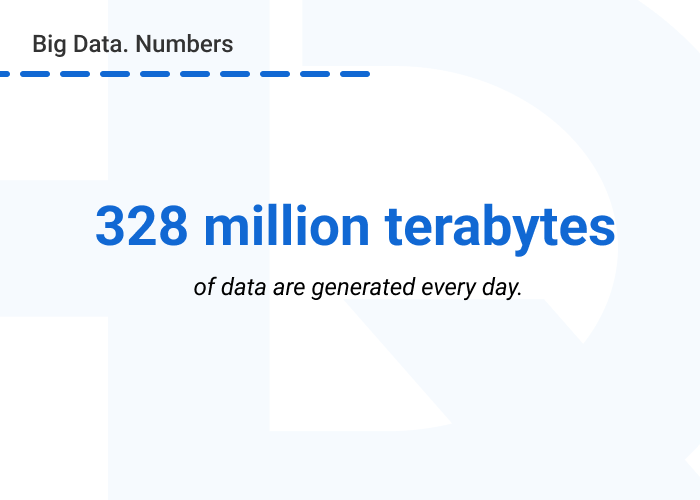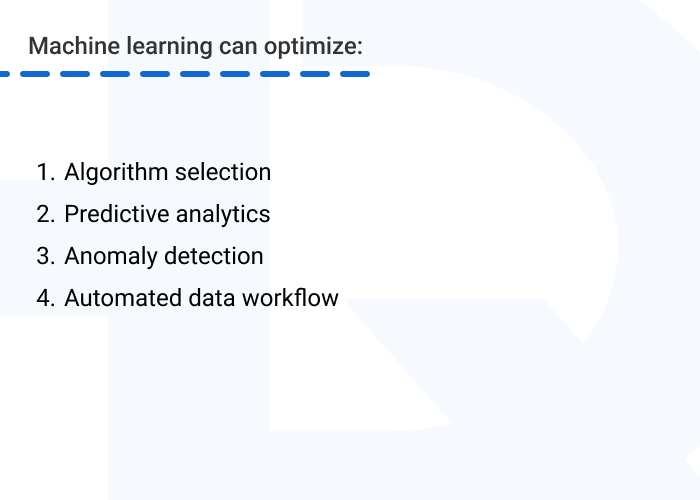How Do You Use Artificial Intelligence (AI) in Big Data Analysis
Optimizing Big Data Analysis Processes with Machine Learning
In a world drowning in 328.77 million terabytes of daily data, traditional analysis in fintech just doesn’t cut it anymore. Enter AI and ML. Thanks to rapid advancements in Artificial Intelligence (AI) and Machine Learning (ML), financial companies now have the opportunity to optimize their Big Data analysis by immediately examining data masses and deriving intelligent predictions.
This post will not only discuss how to use AI in data analytics but also reveal strategies to turn big data into your biggest asset in fintech.
How Do You Use Artificial Intelligence (AI) in Big Data Analysis
Optimizing Big Data Analysis Processes with Machine Learning
Big Data analysis using AI can extract required information and behavior patterns from huge, intricate datasets. This entails using AI modeling, Natural Language Processing (NLP) methods, Deep Learning models, etc., to find patterns and connections in large amounts of structured and unstructured data. In fintech, such data can come from financial transactions, account details, customer feedback and behavior, PDF documents, and more.

You can use AI for data analytics to enhance:
The first step is to prepare Big Data for analysis, to guarantee both data quality and the compatibility of AI algorithms. This procedure usually includes the next steps:
Specifically in fintech, to access market trends, you need an in-depth analysis of a wide range of economic indicators, including inflation rates, employment data, and interest rates, among others. Data flows from multiple sources need to be integrated in this process, and AI is the perfect assistant here. AI seamlessly collects data streams, grouping them based on discernible patterns, and standardizes them to facilitate further analysis.
This approach to data preparation ensures that ultimately you can get accurate data analysis results to make well-informed decisions instead of relying on manual efforts that can lead to numerous human mistakes.
Deep learning focuses on training artificial neural networks to analyze complex and unstructured data, such as images, text, audio, or video. It enables you to quickly and effectively analyze financial news, regulation updates, machine translation, question answering, object analysis, etc.
Deep learning has been incredibly successful in the following areas:
A bright example is JPMorgan Chase, a financial titan in the banking industry, that has harnessed the power of AI image recognition technologies within their fraud detection systems. For instance, the bank uses AI-based data analytics to detect signs of compromise in incoming emails. AI extracts entities, such as company or customer names and language patterns from unstructured data and investigates them for signs of fraud.
Want to enrich your fintech solution with AI/ML technologies? We’re ready to help!HQSoftware has a team of skilled professionals ready to tackle the project. Ask me!
Anna Halias
Business Development Manager
It is impossible to manually analyze huge amounts of data and efficiently validate it without errors. This results in a loss of time and money. That’s where Artificial Intelligence in Big Data analytics can help.
By leveraging AI techniques for data validation, you will be able to automatically identify and rectify errors, anomalies, or inconsistencies in datasets. This not only ensures data reliability but also primes it for advanced AI model training, pivotal in fintech.
Moreover, Big Data in fintech often contains a lot of sensitive information, such as personal account information, transaction records, and private client data, that requires significant anti-loss and anonymization measures. Implementing AI techniques can help protect privacy while maintaining the integrity of the data for analysis purposes.
Once the data is ready, it’s necessary to present the findings in a user-friendly way. AI algorithms don’t just analyze data; they bring it to life through interactive visualizations, making complex patterns accessible and actionable. Interactive visualization technologies driven by AI allow users to visually examine, query, and alter data.
For fintech solutions, AI-driven visualization tools can help display financial data and transaction records in intuitive formats such as heatmaps, treemaps, network graphs, etc., which is crucial for the tax, accounting, and banking sectors.

As a result, by leveraging AI techniques in Big Data data analytics, you can streamline the data preparation phase, enhance the effectiveness of any analysis tasks, reduce manual efforts, and improve data quality, avoiding the possibility of human mistakes.
Now let’s take a look at how ML can optimize Big Data analysis.
Machine Learning is a branch of Artificial Intelligence that develops algorithms to enable software to learn from data, analyze it, and make data-driven predictions. Imagine ML algorithms as your data detectives, uncovering hidden patterns and predicting market trends with uncanny accuracy.
Machine Learning can be leveraged to optimize various aspects of AI/ML analytics, such as:
ML approaches, such as model selection or meta-learning, can determine the optimal algorithm for your task by comparing the performance and outcomes from different Machine Learning algorithms. In addition, meta-learning can adjust the chosen algorithm over time to improve data accuracy.
In this way, you can choose the most appropriate algorithm for data analysis, one that will provide the most accurate outcomes.
To provide you with valuable insights into future trends, ML models can make accurate predictions about future outcomes by training on historical data. Such models continuously learn from incoming data streams, which increase prediction accuracy.
This is particularly valuable in the fintech industry, where forecasting demand, customer behavior, or market trends can drive strategic decision-making and resource allocation.
By analyzing historical data, such as transaction records, customer data, historical market data, and relevant economic indicators, predictive analytics can help you:
Anomaly detection using AI/ML analytics can automatically identify data patterns that differ from the majority.
Such anomalies indicate deviations within a specific time frame and should be investigated to assess their potential impact on your business. Anomalies can encompass both positive fluctuations, indicating new business opportunities, and negative fluctuations, such as potential instances of fraudulent activity.
These insights can be very useful for making decisions in fintech companies for fraud detection, credit scoring, cybersecurity, and more. For instance, it can help you decide whether to proceed with the transaction or stop it.
ML algorithms can help you determine time-consuming tasks and optimize them in the following ways:

A combination of ML techniques and Big Data analysis can enable faster data processing and maintaining outcome accuracy by enabling extraction and analysis of important information from complex datasets in real-time.
Understanding the data, selecting the right algorithms, training models, and continuously improving them are key steps to optimizing data analytics with AI in fintech. By using AI and ML algorithms, you will be able to unlock the potential of Big Data for your financial services, including:
Despite all the benefits of incorporating AI and data analytics into your software, it’s crucial to remember that ML-powered solutions call for cautious data handling, model validation, and ethical and legal compliance by human oversight and experience. This is where a reliable software development company can help.
By partnering with HQSoftware, you will be able to develop reliable fintech software enriched with AI and ML technologies for successful Big Data analysis. Our specialists are experienced in cooperating with financial startups, from the idea stage to the delivery of highly ranked fintech solutions. Our happy clients’ response to the results of their financial and AI/ML projects can attest to this.
Contact us to transform your data from a static resource into a dynamic tool that drives decisions, innovation, and growth.

Head of Production
To ensure the outstanding quality of HQSoftware’s solutions and services, I took the position of Head of Production and manager of the Quality Assurance department. Turn to me with any questions regarding our tech expertise.
We are open to seeing your business needs and determining the best solution. Complete this form, and receive a free personalized proposal from your dedicated manager.

Sergei Vardomatski
Founder